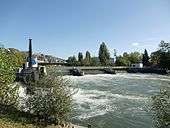Werdinsel
| Native name: <span class="nickname" ">Werdinsel Nickname: Werd; Flussbad Au-Höngg; Limmatauen; Werdhölzli | |
|---|---|
|
Werdinsel in the Limmat in Zürich | |
 Werdinsel Location in Switzerland | |
| Geography | |
| Location | Limmat |
| Coordinates | 47°24′00″N 8°29′15″E / 47.4000°N 8.4875°ECoordinates: 47°24′00″N 8°29′15″E / 47.4000°N 8.4875°E |
| Total islands | 1 |
| Area | 0.06 km2 (0.023 sq mi) |
| Highest elevation | 403 m (1,322 ft) |
| Administration | |
| Canton | Zürich |
| District | Höngg |
| Demographics | |
| Population | 0 (December 2014) |
Werdinsel, also known as Limmatauen Werdhölzli, is an island and protected area in the Limmat in Switzerland.


Geography
Located in the former independent municipality of Höngg, today the river island is a popular recreation area, public park and bath in the Limmat, situated in the northernly suburban area of the Limmat Valley in Zürich. The island has a maximum length of about 550 metres (1,804 ft) and a maximum width of about 125 metres (410 ft). Its highest point is about 403 metres (1,322 ft) above sea level, a few metres above the river level at Zürich-Höngg. The minimum distance from the river bank is about 10 metres (33 ft), and the island is also separated by the artificial Giessen channel.
Recreation
The so-called Flussbad Au-Höngg is one of the four public river baths situated in the Limmat within the city of Zürich. The entrance is free, but there is just a limited infrastructure. The Zürich tram line 17 (stop Tüffenwies) and the local Verkehrsbetriebe Zürich VBZ bus lines 80 and 89 (stop Winzerhalde) provide public transportation.[1] The island also houses a restaurant and grill stations, family gardens, sand beaches and a forested area, the adjoint Limmat-Auen Werdhölzli protected area.
Since decades, the river island may called a 'conflict zone' related to its public use; so claim the holders of dogs, FKK and LGBT enthusiasts, as well as families the area for their own purposes. Another problem is the intensive use, so on peak days, up to 4,500 visitors search for recreation, almost half a million a year, among them also people from neighboring cantons, and therefore causing additional road transport traffic. The city police, however, legally alloweds to move any naked people in public, and even outdoor sex is not illegal as long as no one raise indictment. The city police forces regularly patrols on the ground,[2][3] and the municipal authorities started to assign beware of the naked signs in August 2015.[4]
Limmatauen
Limmatauen Werdhölzli is a protected forest and river area, partially situated in the municipality of Oberengstringen, between the weir at the Höngg power plant, resulting in a more than 130 years old flood protection plan between two neighbored municipalities. Set under protection in 1945, the 1.8 kilometres (1.1 mi) long section of the Limmat was renatured, what enhanced the biodiversity, and thus the quality of the river landscape.[5] In cooperation with the Canton of Zurich, the municipalities of Oberengstringen and Zürich, that section of the river was renewed to September 2013. In addition to improved access to the Limmat and the hiking path towards the Fahr Abbey, the area was widened for pedestrians and cyclists. Orientation boards inform on the endemic flora and fauna, so the riparian zone may be crossed over a 320 metres (1,050 ft) long wooden bridge those material consists of the urban forests, and allows to discover with open eyes and senses what lives and grows here. Along the ridge there are installed bat boxes in the trees. After nearly a year of construction, the project was officially presented to the public on 20 September 2013. The costs of 9.4 million Swiss Francs, are provided by the city and cantonal government, and some companies in collaboration with the World Wildlife Fund Switzerland, which claims the place as very important to our rivers and streams, so that they can create their very structure.[6][7]
Cultural heritage
A watermill of the Wettingen Abbey was first mentioned in 1365. The island is a historical site of water industrialization in Zürich, and also houses the former spinning mill Strickler, as well as the Kraftwerk Werd, one of the oldest power plants in Zürich. Werd is an old term used in German language for a river island, and Au is meaning a small forest at a body of water.[8] The sites are listed in the Swiss inventory of cultural property of national and regional significance.[9]
Trivia
As in Switzerland, both burials and cremations are permitted by law, the island respectively the river is also used for flow burials.[10]
References
- ↑ "Flussbad Au-Höngg" (in German). Schul- und Sportdepartement Stadt Zürich. Retrieved 2015-01-15.
- ↑ "Die Werdinsel ist und bleibt ein heiss umkämpftes Gebiet" (in German). Limmattaler Zeitung. 2014-05-14. Retrieved 2015-01-15.
- ↑ "Werdinsel Zürich: Sex auf der Insel – Polizei knüpft sich Liebende vor" (in German). 20min.ch. 2014-06-06. Retrieved 2015-06-07.
- ↑ "Nach 50 Jahren warnen Schilder vor Nacktbadenden" (in German). Limmattaler Zeitung. 2015-08-19. Retrieved 2015-08-20.
- ↑ "Limmatauen Werdhölzli – Perle am Stadtrand" (in German). Tiefbau- und Entsorgungsdepartement Stadt Zürich. Retrieved 2015-01-15.
- ↑ "Die Limmat fliesst jetzt mitten durch den Wald" (in German). Tages-Anzeiger. 2013-09-18. Retrieved 2015-01-15.
- ↑ "Renaturierte Limmatauen Werdhölzli" (in German). World Wildlife Fund Switzerland. Retrieved 2015-11-01.
- ↑ Gebrüder Dürst. "Werdinsel" (in German). Retrieved 2015-01-14.
- ↑ "A-Objekte KGS-Inventar". Schweizerische Eidgenossenschaft, Amt für Bevölkerungsschutz. 2009. Retrieved 2015-01-15.
- ↑ "Einstein und die letzte Ruhe" (in German). Einstein (TV series). 2015-10-29. Retrieved 2015-11-01.
External links
| Wikimedia Commons has media related to Werdinsel. |